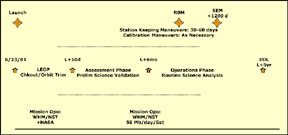
|
Mission Detail
The baseline mission starts with a single launch of both the GRACE satellites on board the ROCKOT launch vehicle on March 17, 2002, from Plesetsk (62.7° N, 40.3° E) Russia. The re-ignitable third stage BREEZE will be used to place both satellites in the same nominal orbit. The GRACE mission will be launched just past the solar flux maximum of Cycle 23. The mission lifetime is divided into five phases. These are the Pre-Launch Phase, Launch and Early Operations Phase (LEOP), the Commissioning Phase, the Validation Phase and the Observational Phase. After the LEOP operations, the orbits of the two satellites will evolve naturally for the remainder of the mission. During the science data collection, the satellites will be in a nominally Earth pointed orientation, with the two K-Band antennae pointing along the line-of-sight to a high precision. During the mission lifetime, the telemetry and telecommand activities will be carried out by GSOC at the Mission Control Center in Oberpfaffenhofen, using the Weilheim and Neustrelitz ground stations in Germany. Additional contingency support from other NASA stations will be available as necessary. Approximately 50 Mbytes/day/satellite of science data, including both gravity and GPS occultation, will be down-linked using S-Band telemetry. The DLR/DFD will serve as the Raw Data Center with its ground station at Neustrelitz. The downlinked science data will be analyzed, processed and distributed to the science community by the Science Data System after appropriate calibration and validation. On an average over the mission lifetime, the ground tracks of the satellites will trace sufficiently dense patterns on the Earth approximately every 30 days, so that a global gravity field solution will be reported from the science data collected in that duration. Over the mission lifetime, the two satellites will remain in co-planar orbits. Due to drag force differences, the along-track separation will be variable. Station-keeping maneuvers will be carried out every 30 to 60 days, as necessary, to keep the two satellites at their nominal separation. To ensure the uniform exposure and aging of the K-Band antennae in the two satellites, once during the mission the leading and trailing satellites will exchange positions. The altitudes of the two satellites will decay in tandem, from near 500 km at the beginning of the mission, to 300 km and lower at the end of mission. In order to ensure an overall mission lifetime of five years, the altitudes of the two satellites may be re-boosted once, if deemed necessary. At various intervals in the mission, it will be also necessary to carry out certain science instrument calibration maneuvers. A high-level mission timeline, showing this mission synopsis, is shown below.

Nominal Mission Lifetime. (SEM=Satellite Exchange Maneuver, RBM=Re-Boost Maneuver; WHM=Weilheim, NST=Neustrelitz) |

